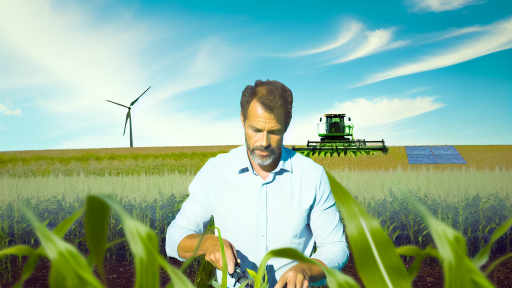Introduction to Sustainable Agriculture and Its Economic Impacts
Sustainable agriculture plays a crucial role in modern farming practices.
It promotes environmental health and economic viability.
Farmers adopting sustainable methods often experience numerous economic benefits.
Enhanced Profitability
Many sustainable practices lead to increased profitability.
The reduction in chemical inputs decreases costs for farmers.
Additionally, organic products often command higher market prices.
These factors contribute to an overall boost in income for producers.
Job Creation
Sustainable agriculture generates new employment opportunities.
It often requires skilled labor for maintaining diverse crops and livestock.
As a result, local communities benefit from increased job availability.
Increased Resilience
Farmers employing sustainable methods enjoy increased resilience.
They adapt more effectively to climate-related challenges.
This leads to stable production levels during adverse conditions.
Boosting Local Economies
Sustainable agriculture supports local economies through community engagement.
It encourages consumers to buy locally, keeping money within the community.
Transform Your Agribusiness
Unlock your farm's potential with expert advice tailored to your needs. Get actionable steps that drive real results.
Get StartedLocal farms contribute to agricultural diversity and regional food security.
Long-term Viability
Investing in sustainable agriculture fosters long-term economic health.
It ensures the preservation of resources for future generations.
This approach also promotes multi-generational farming practices.
Cost Savings Associated with Sustainable Farming Practices
Reduction in Input Costs
Sustainable farming reduces reliance on costly chemical fertilizers.
Farmers can utilize organic compost instead, promoting healthier soil.
Moreover, conserving water through rainwater harvesting cuts irrigation expenses.
Cover crops help in preventing soil erosion, decreasing land degradation costs.
Energy Efficiency Improvements
Implementing energy-efficient machinery saves fuel costs.
Farmers can also adopt renewable energy sources, such as solar panels.
By using fewer fossil fuels, they lower operational costs significantly.
Furthermore, these practices contribute to a reduction in greenhouse gas emissions.
Long-Term Economic Stability
Sustainable practices enhance soil fertility over time.
Healthier soils lead to higher yields, boosting overall profitability.
By improving biodiversity, farmers can reduce pest impacts more effectively.
This increases resilience against market fluctuations in crop prices.
Access to Premium Markets
Many consumers prefer organic and sustainably grown products.
Catering to this market can command higher prices for products.
Consequently, farmers experience improved revenue streams.
Participating in local food networks enhances community support and sales.
Government Incentives and Support
Various governments offer financial programs for sustainable practices.
Farmers can access grants to support eco-friendly initiatives.
Additionally, tax incentives motivate investment in sustainable improvements.
These support structures can lead to significant cost reductions overall.
Showcase Your Farming Business
Publish your professional farming services profile on our blog for a one-time fee of $200 and reach a dedicated audience of farmers and agribusiness owners.
Publish Your ProfileIncreased Crop Yields through Sustainable Techniques
Improved Soil Health
Sustainable agriculture enhances soil health significantly.
It uses practices like crop rotation and cover cropping.
These methods increase soil organic matter and fertility.
Moreover, healthier soil improves water retention.
This leads to higher resistance against drought.
Reduction of Chemical Inputs
Farmers adopting sustainable methods reduce chemical inputs.
They replace synthetic fertilizers with natural alternatives.
This change decreases soil and water pollution levels.
Additionally, it enhances the overall health of ecosystems.
Crop Diversity and Intercropping
Practicing crop diversity boosts ecosystem resilience.
Intercropping different species promotes healthier yields.
This strategy protects crops from pests and diseases.
Consequently, farmers can minimize their pesticide use.
Utilization of Advanced Techniques
Farmers implement new technologies in sustainable agriculture.
They use precision farming to optimize resource use.
This approach improves efficiency in water and nutrient application.
As a result, growers can achieve higher yields sustainably.
Case Studies of Success
Many farms have reported increased yields through sustainability.
The Green Valley Organics farm in Oregon exemplifies this success.
By using cover crops, they saw a 30% increase in yields.
Moreover, the Emerald Fields Cooperative reduced pesticide costs by 40%.
Such examples illustrate the potential of sustainable practices.
Uncover the Details: Integrate Cover Crops for Better Carbon Storage
Market Demand for Organic and Sustainable Products
Growing Consumer Awareness
Consumers are increasingly aware of the impact of their food choices.
This awareness drives demand for organic options.
Consequently, brands that offer sustainable products can capitalize on this trend.
Health Benefits
Many customers believe organic food is healthier than conventional options.
This belief stems from the absence of synthetic additives and pesticides.
As a result, health-conscious consumers seek out organic and sustainable options.
Environmental Concerns
The environmental impact of agriculture is a growing concern for many.
Consequently, consumers prefer products that promote ecological sustainability.
They often choose brands that demonstrate responsible farming practices.
Market Growth Statistics
Recent studies show a rapid increase in sales of organic products.
For instance, the organic food market saw growth of over 10% last year.
Moreover, this growth is projected to continue in the coming years.
Impact on Pricing
Organic products often command higher prices.
This pricing reflects the increased cost of sustainable farming methods.
Consumers are willing to pay more for products that align with their values.
Retail Landscape Adaptation
Retailers are adapting to the rising demand for organic goods.
Many grocery stores now allocate more shelf space for sustainable products.
Showcase Your Farming Business
Publish your professional farming services profile on our blog for a one-time fee of $200 and reach a dedicated audience of farmers and agribusiness owners.
Publish Your ProfileThis shift reflects changing consumer preferences in the retail market.
Learn More: Farmers’ Guide to Surviving Climate Change Challenges
Long-Term Viability and Soil Health Benefits
Ensuring Sustainable Productivity
Sustainable agriculture offers long-term viability for farming practices.
This approach improves productivity through enhanced soil health.
Healthy soil retains nutrients and moisture, supporting plant growth.
Farmers notice increased yields as soil quality improves over time.
Additionally, sustainable methods reduce input costs for farmers.
Improving Soil Health
Soil health is essential for agricultural sustainability.
It influences crop performance and ecological balance.
Sustainable agriculture practices, like crop rotation, enhance soil structure.
These practices increase organic matter and biodiversity in soil.
As a result, soil becomes more resilient to erosion and nutrient loss.
Enhancing Environmental Quality
Improving soil health directly benefits environmental quality.
Healthy soils filter water and reduce runoff pollution.
This leads to cleaner water sources for surrounding ecosystems.
Moreover, a focus on soil health supports carbon sequestration.
Ultimately, this helps mitigate climate change impacts.
Building Resilience Against Climate Variability
Healthy soils foster resilience against climate variability.
Crops grown in sustainable systems perform better during droughts.
Sustained soil health increases its ability to retain water.
Consequently, farmers can withstand changing weather conditions.
This adaptability is crucial for long-term agricultural success.
You Might Also Like: Impact Of Extreme Weather On Farming Costs

Job Creation in Sustainable Agriculture Sector
Overview of Job Opportunities
Sustainable agriculture generates diverse job opportunities across various sectors.
These opportunities span farming, research, and education.
Job roles include agricultural technicians, researchers, and farm managers.
Furthermore, workers in organic farming experience increased demand.
Impact of Local Farms
Local farms play a crucial role in job creation.
They often hire a workforce from the surrounding community.
This strengthens local economies and fosters community ties.
Moreover, local farms reduce transportation costs and promote area-specific employment.
Growth in Related Industries
Sustainable agriculture also stimulates growth in related industries.
These industries include food processing, distribution, and retail.
As sustainable practices expand, new businesses emerge to support them.
Additionally, demand for environmentally-friendly products further drives job creation.
Training and Education Initiatives
Educational programs focus on sustainable agriculture’s job skills.
Universities and vocational schools now offer specialized courses.
These programs prepare students for careers in sustainable farming.
Consequently, a skilled workforce supports the sustainable agriculture movement.
Policy Support for Job Creation
Governments are increasingly recognizing the importance of sustainable agriculture.
Showcase Your Farming Business
Publish your professional farming services profile on our blog for a one-time fee of $200 and reach a dedicated audience of farmers and agribusiness owners.
Publish Your ProfileThey implement policies that promote job growth in this sector.
Incentives may include grants and funding for sustainable farming initiatives.
This approach nurtures both job creation and ecological balance.
See Related Content: Practical Farming Tips to Combat Climate Change
Government Incentives and Subsidies for Sustainable Practices
Understanding Government Support
Governments worldwide recognize the importance of sustainable agriculture.
To encourage adoption, many offer financial incentives to farmers.
These incentives often include grants, subsidies, and low-interest loans.
Such measures aim to reduce the initial costs of sustainable practices.
Consequently, farmers can invest in eco-friendly technologies.
Types of Government Incentives
Various types of government incentives can support sustainable agriculture.
- Direct subsidies for organic farming products
- Tax credits for renewable energy installations
- Cost-sharing programs for conservation practices
- Research grants for sustainable agricultural innovations
These incentives help farmers transition to sustainable methods effectively.
Benefits of Financial Support
Financial support from governments provides numerous benefits.
First, it lowers the financial burden on farmers transitioning to sustainable practices.
Second, it encourages environmentally friendly farming techniques.
Moreover, it promotes innovation in agricultural methods.
Ultimately, these benefits contribute to long-term sustainability in agriculture.
Case Studies of Successful Programs
Many countries have implemented successful incentive programs.
For example, Germany offers extensive subsidies for organic farming practices.
This program has significantly increased organic farming acreage.
Similarly, Australia’s carbon farming initiative incentivizes emissions reduction.
Such case studies demonstrate the effectiveness of governmental support.
Case Studies: Successful Economies Using Sustainable Agriculture
Success in Costa Rica
Costa Rica demonstrates successful sustainable agriculture practices.
The country integrates farming with ecological preservation.
Agricultural exports include organic coffee and bananas.
These exports generate significant revenue for the economy.
Farmers adopt agroforestry techniques to enhance productivity.
This method improves biodiversity and soil quality.
Innovations in India
India employs sustainable practices in various regions.
For example, farmers use traditional methods for pest control.
Organic cotton farming has gained traction in several states.
This approach increases farmers’ income while reducing costs.
Additionally, community-supported agriculture networks thrive.
These networks strengthen local economies by connecting consumers with farmers.
Growth in the Netherlands
The Netherlands leads in sustainable agricultural technology.
Greenhouses utilize renewable energy sources efficiently.
Vertical farming has emerged as an innovative solution.
This model maximizes space and minimizes resource usage.
Consequently, the country’s agricultural productivity remains high.
Exports include flowers, vegetables, and fruits to global markets.
Advancements in Brazil
Brazil showcases the potential of sustainable agriculture at scale.
Showcase Your Farming Business
Publish your professional farming services profile on our blog for a one-time fee of $200 and reach a dedicated audience of farmers and agribusiness owners.
Publish Your ProfileIts focus on integrated crop-livestock-forestry systems is notable.
This method enhances land use efficiency and reduces deforestation.
Farmers have reported increased profits due to these practices.
Moreover, sustainable soy farming practices are being implemented.
This shift attracts environmentally conscious consumers.
Additional Resources
Climate Change Impacts on Agriculture and Food Supply | US EPA
Cover Cropping to Improve Climate Resilience | USDA Climate Hubs




